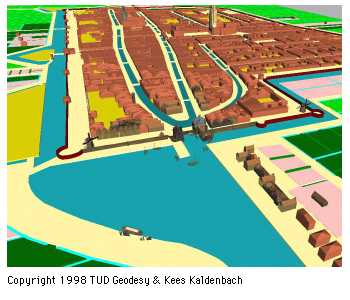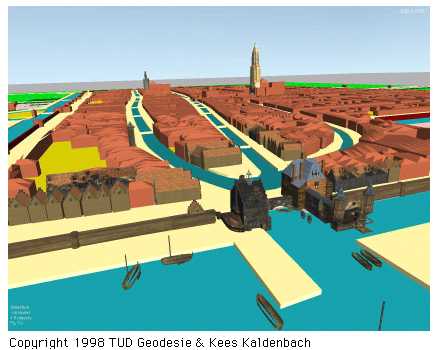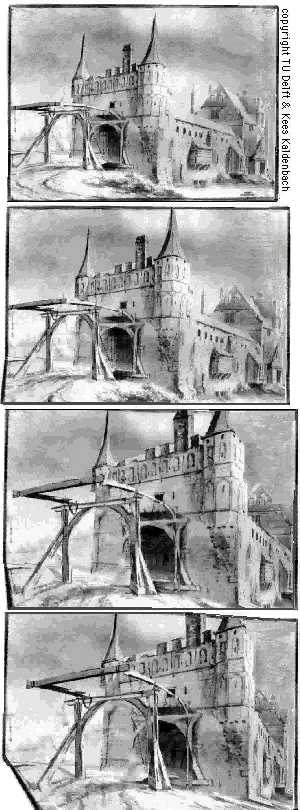Expanding Vermeer's 1660 painting "The View of Delft" into a
3D Virtual Reality flight over Delft and a QuickTime "Walk Through
Drawings of The View of Delft Area"
Lecture and Computer Demonstration presented during the CIHA
conference, London, September 5, 2000.
Drs. Kees Kaldenbach
Johannes Vermeer's famous painting "The View of Delft" (1660-1663)
in the Mauritshuis, The Hague is currently the subject of two
QuickTime movies. These are movies which can be transported on
Internet, and viewed on a computer. The first is a 3D Virtual
Reality flight over Delft 1660 and the second is A walk
through drawings of the gates shown in Vermeer's 'View of
Delft'. As a new and exciting experience these movies are
didactically oriented towards both art historians as well as those
who hardly ever visit an art museum.
3D Virtual Reality Flight over Delft 1660
 Inspired
by his long topographical study of the area of the painting, in 1997
the author initiated a virtual reality (vr) 3D flight over the Delft
of 1660. This was carried out by the Delft University of
Technology (TUD) who had built the necessary software for the vr
flight with 'Karma'. Karma was created by two TUD faculties; the
Geodesy sub-faculty in collaboration with Technical
Mathematics and Informatics. For this project a 1650/1660s map of
Delft was digitized. Then the resulting data set was coded and worked
into a virtual 3D model of Delft as it must have once looked from a
distance. Due to the powerful Karma software, viewers can actually
view a real time free-flight over this model; either on a computer
screen or projected by video onto a large wall.
Inspired
by his long topographical study of the area of the painting, in 1997
the author initiated a virtual reality (vr) 3D flight over the Delft
of 1660. This was carried out by the Delft University of
Technology (TUD) who had built the necessary software for the vr
flight with 'Karma'. Karma was created by two TUD faculties; the
Geodesy sub-faculty in collaboration with Technical
Mathematics and Informatics. For this project a 1650/1660s map of
Delft was digitized. Then the resulting data set was coded and worked
into a virtual 3D model of Delft as it must have once looked from a
distance. Due to the powerful Karma software, viewers can actually
view a real time free-flight over this model; either on a computer
screen or projected by video onto a large wall.
The technology behind the 3D effect requires some
explanation. The software generates two nearly simultaneous images;
one as seen with the left eye from coordinate point x-y-z and the
other as seen by the right eye from some 10 to 20 centimeters
immediately to the right of this point. Both images are then produced
very rapidly in succession on the same screen at a rate of about 30
times a second. Special electronic eyeglasses make it possible to
quickly block and free the viewing eye from the left eye to the right
one at the same frequency. Thanks to the adaptative power of the
human eye, the wonderful impression of spatial 3D occurs.
 The
Geodesy sub-faculty was able and willing to execute this
project to showcase their technological abilities. The first flight
was achieved in November 1997, and the result subsequently exhibited
in the Delft Technical Museum. An interview with the team of
producers was shown on a local television network at that time.
The
Geodesy sub-faculty was able and willing to execute this
project to showcase their technological abilities. The first flight
was achieved in November 1997, and the result subsequently exhibited
in the Delft Technical Museum. An interview with the team of
producers was shown on a local television network at that time.
In 2000 a small QuickTime version of the flight will be produced
showing one fixed-path flight over Delft. This video movie is
available on the internet in 2001. The 3D effect will not be
available as the necessary software and special glasses required are
not widely distributed.
For more technical detail discussed in English, Dutch, German and
French and a story about Vermeer's painting see the author's
home page.
A walk through the drawings of the gates shown in Vermeer's
'View of Delft'
 Another
project initiated by the author is a Quick-time movie showing a walk
through the gates of Vermeer's Delft in 1660. It is currently being
produced by the Industrial Design Department of the OCP faculty
(Design Engineering and Production) of the Delft University of
Technology (TUD). Since 1975 the author has collected a large
number of views (photographs, paintings, drawings, engravings) of the
area depicted by Vermeer in his "View of Delft". In May 2000 this
project began by scanning selected images from the Delft Archives,
which graciously gave their full cooperation. These basic images were
then manipulated with Canoma., a commercially available
software package which allows any photograph of a spatial object to
be quickly (but imperfectly) translated into a spatial scene. Objects
within the scene must then be identified and tagged as rectangles,
cones, spheres etc. After this tagging is finished one is able to
take a virtual camera through the resulting electronic image, going
forward, up, down, left or right, into any desired direction. A
succession of these images generated by Canoma can then be spliced
and electronically fused into a continuous walk through the ancient
town gates of Delft as they appeared in the 17th and 18th centuries.
This area in the south of Delft where tow boats (an early form of
public transportation) once docked, has been sketched, drawn and
engraved by many artists throughout the ages. So many examples have
been kept for posterity that a true-to-life virtual reality
recreation of the physical site is possible. Because so many images
were available it has become possible to create a continuous virtual
walk from the outer edge of town, via the Rotterdam Gate (see image
to the left - it is the gate on the right hand side of the Vermeer
painting) onto the bridge where one can see a wide arc of the town
from within.
Another
project initiated by the author is a Quick-time movie showing a walk
through the gates of Vermeer's Delft in 1660. It is currently being
produced by the Industrial Design Department of the OCP faculty
(Design Engineering and Production) of the Delft University of
Technology (TUD). Since 1975 the author has collected a large
number of views (photographs, paintings, drawings, engravings) of the
area depicted by Vermeer in his "View of Delft". In May 2000 this
project began by scanning selected images from the Delft Archives,
which graciously gave their full cooperation. These basic images were
then manipulated with Canoma., a commercially available
software package which allows any photograph of a spatial object to
be quickly (but imperfectly) translated into a spatial scene. Objects
within the scene must then be identified and tagged as rectangles,
cones, spheres etc. After this tagging is finished one is able to
take a virtual camera through the resulting electronic image, going
forward, up, down, left or right, into any desired direction. A
succession of these images generated by Canoma can then be spliced
and electronically fused into a continuous walk through the ancient
town gates of Delft as they appeared in the 17th and 18th centuries.
This area in the south of Delft where tow boats (an early form of
public transportation) once docked, has been sketched, drawn and
engraved by many artists throughout the ages. So many examples have
been kept for posterity that a true-to-life virtual reality
recreation of the physical site is possible. Because so many images
were available it has become possible to create a continuous virtual
walk from the outer edge of town, via the Rotterdam Gate (see image
to the left - it is the gate on the right hand side of the Vermeer
painting) onto the bridge where one can see a wide arc of the town
from within.
In 2001 results will be available for viewing on the author's
home page. Both these
QuickTime movies could one day also be used for other purposes, as
part of a CD-rom or vr program or in a television program focusing on
the multitude of artists, artisans and patrons living in 17th century
Delft. Part of this project will be a clickable map showing the
location of the addresses of some 70 artists and 70 patrons in 17th
century Delft located by the present author. This research is also
presented in the 2001 exhibition Vermeer and the Delft School
in the Metropolitan Museum of Art, NYC and the National Gallery,
London. John Michael Montias, the foremost authority on the subject
of artists and artisans in 17th century Delft and who has published
widely on the subject, has kindly agreed to the use of his findings
in future projects.
As one of the highlights of Western painting the subject of the
'View of Delft' is a particularly suitable subject. Although
only vestiges of its former grandeur are now visible at the actual
site, 21st century technology enables us to show a moving virtual
reality image of Delft as it was in 1660. Images may help in
temporarily bridging the gap between a youthful image-oriented pop
culture public and those in the field of fine arts and art
history.
Note on a personal quest. My fascination with Johannes Vermeer's
paintings dates from my stunned reaction to his grand canvas "The
Art of Painting" when I visited Vienna in 1975. Reading such
books as Albert Blankert's wonderful 1975 Vermeer biography I became
aware that no in-depth research had been done as to the topographic
reality of a 'View of Delft'. This set me on a quest which has not
yet ended. Vermeer paintings fascinates me on at least three levels,
as an image with "near vr qualities", as a source of enigma within
the art of storytelling and as tangible paintings, wonderfully and
near magically crafted layers of paint on canvas.
Drs. Kees Kaldenbach, Amsterdam, September 2000.
e-mail kalden@xs4all.nl
http://www.johannesvermeer.org
http://www.xs4all.nl/~kalden/
Lecture presented on 3 September 2000 at "CIHA London 2000", the
Thirtieth International Congress of the History of Art from 3-8
September 2000. The theme was "Art History for the Millennium: Time"
Section 23 was about Digital Art History Time. The internet site was
shown at the electronic poster session "Computer Demonstrations" in
section 23-Z
Drs. Kees Kaldenbach originally trained as a teacher and is
currently an independent art historian in Amsterdam, Holland. A
member of AHWA, he is Co-chair of the AHWA
Digital Teaching Committee. He is also member of the Association
for Art History and of the International
Society For Mathematical And Computational Aesthetics and a
contributor of the Dutch Ars
et Mathesis Foundation.
In 2001 a QT film of this flight will be presented. Stay
tuned.
 Inspired
by his long topographical study of the area of the painting, in 1997
the author initiated a virtual reality (vr) 3D flight over the Delft
of 1660. This was carried out by the Delft University of
Technology (TUD) who had built the necessary software for the vr
flight with 'Karma'. Karma was created by two TUD faculties; the
Geodesy sub-faculty in collaboration with Technical
Mathematics and Informatics. For this project a 1650/1660s map of
Delft was digitized. Then the resulting data set was coded and worked
into a virtual 3D model of Delft as it must have once looked from a
distance. Due to the powerful Karma software, viewers can actually
view a real time free-flight over this model; either on a computer
screen or projected by video onto a large wall.
Inspired
by his long topographical study of the area of the painting, in 1997
the author initiated a virtual reality (vr) 3D flight over the Delft
of 1660. This was carried out by the Delft University of
Technology (TUD) who had built the necessary software for the vr
flight with 'Karma'. Karma was created by two TUD faculties; the
Geodesy sub-faculty in collaboration with Technical
Mathematics and Informatics. For this project a 1650/1660s map of
Delft was digitized. Then the resulting data set was coded and worked
into a virtual 3D model of Delft as it must have once looked from a
distance. Due to the powerful Karma software, viewers can actually
view a real time free-flight over this model; either on a computer
screen or projected by video onto a large wall. The
Geodesy sub-faculty was able and willing to execute this
project to showcase their technological abilities. The first flight
was achieved in November 1997, and the result subsequently exhibited
in the Delft Technical Museum. An interview with the team of
producers was shown on a local television network at that time.
The
Geodesy sub-faculty was able and willing to execute this
project to showcase their technological abilities. The first flight
was achieved in November 1997, and the result subsequently exhibited
in the Delft Technical Museum. An interview with the team of
producers was shown on a local television network at that time. Another
project initiated by the author is a Quick-time movie showing a walk
through the gates of Vermeer's Delft in 1660. It is currently being
produced by the Industrial Design Department of the OCP faculty
(Design Engineering and Production) of the Delft University of
Technology (TUD). Since 1975 the author has collected a large
number of views (photographs, paintings, drawings, engravings) of the
area depicted by Vermeer in his "View of Delft". In May 2000 this
project began by scanning selected images from the Delft Archives,
which graciously gave their full cooperation. These basic images were
then manipulated with Canoma., a commercially available
software package which allows any photograph of a spatial object to
be quickly (but imperfectly) translated into a spatial scene. Objects
within the scene must then be identified and tagged as rectangles,
cones, spheres etc. After this tagging is finished one is able to
take a virtual camera through the resulting electronic image, going
forward, up, down, left or right, into any desired direction. A
succession of these images generated by Canoma can then be spliced
and electronically fused into a continuous walk through the ancient
town gates of Delft as they appeared in the 17th and 18th centuries.
This area in the south of Delft where tow boats (an early form of
public transportation) once docked, has been sketched, drawn and
engraved by many artists throughout the ages. So many examples have
been kept for posterity that a true-to-life virtual reality
recreation of the physical site is possible. Because so many images
were available it has become possible to create a continuous virtual
walk from the outer edge of town, via the Rotterdam Gate (see image
to the left - it is the gate on the right hand side of the Vermeer
painting) onto the bridge where one can see a wide arc of the town
from within.
Another
project initiated by the author is a Quick-time movie showing a walk
through the gates of Vermeer's Delft in 1660. It is currently being
produced by the Industrial Design Department of the OCP faculty
(Design Engineering and Production) of the Delft University of
Technology (TUD). Since 1975 the author has collected a large
number of views (photographs, paintings, drawings, engravings) of the
area depicted by Vermeer in his "View of Delft". In May 2000 this
project began by scanning selected images from the Delft Archives,
which graciously gave their full cooperation. These basic images were
then manipulated with Canoma., a commercially available
software package which allows any photograph of a spatial object to
be quickly (but imperfectly) translated into a spatial scene. Objects
within the scene must then be identified and tagged as rectangles,
cones, spheres etc. After this tagging is finished one is able to
take a virtual camera through the resulting electronic image, going
forward, up, down, left or right, into any desired direction. A
succession of these images generated by Canoma can then be spliced
and electronically fused into a continuous walk through the ancient
town gates of Delft as they appeared in the 17th and 18th centuries.
This area in the south of Delft where tow boats (an early form of
public transportation) once docked, has been sketched, drawn and
engraved by many artists throughout the ages. So many examples have
been kept for posterity that a true-to-life virtual reality
recreation of the physical site is possible. Because so many images
were available it has become possible to create a continuous virtual
walk from the outer edge of town, via the Rotterdam Gate (see image
to the left - it is the gate on the right hand side of the Vermeer
painting) onto the bridge where one can see a wide arc of the town
from within.